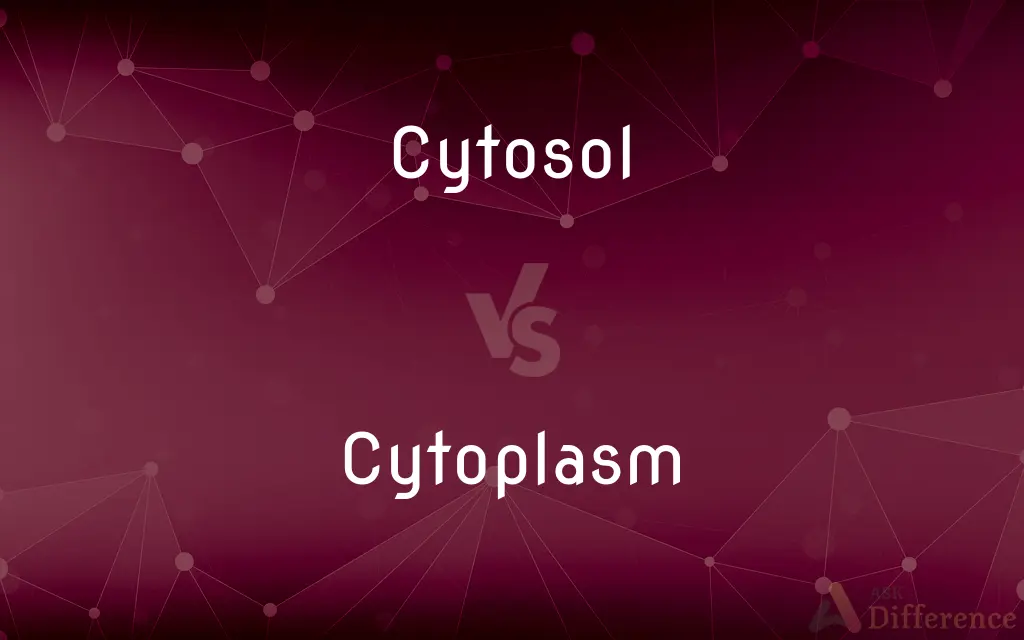Cytosol vs. Cytoplasm — What's the Difference?
By Tayyaba Rehman — Updated on October 3, 2023
Cytosol is the liquid matrix inside cells, excluding organelles. Cytoplasm encompasses both the cytosol and cell organelles, excluding the nucleus.

Difference Between Cytosol and Cytoplasm
Table of Contents
ADVERTISEMENT
Key Differences
Cytosol and Cytoplasm are two terms frequently mentioned in cell biology. The Cytosol is the aqueous, gel-like substance that fills the interior of cells. This matrix is where various metabolic reactions take place. On the other hand, the Cytoplasm refers to the entire content within the cell membrane, minus the nucleus.
Cytosol and Cytoplasm are integral to cellular functions. While the Cytosol primarily houses enzymes that drive metabolic reactions, it also contains dissolved nutrients, ions, and waste products. Conversely, the Cytoplasm is a more expansive term that includes both the Cytosol and cell organelles, like mitochondria, endoplasmic reticulum, and golgi apparatus.
The difference between Cytosol and Cytoplasm is essentially one of inclusion. Cytosol represents just a part of the Cytoplasm, excluding the organelles. However, Cytoplasm is a collective term, encompassing everything inside the cell boundary, save for the nucleus.
In discussions about cell composition, Cytosol and Cytoplasm are vital concepts. Recognizing that the Cytosol is just a component of the Cytoplasm helps clarify the role and location of various cellular processes. It's essential to differentiate between the two to understand cell functionality and structure.
Comparison Chart
Definition
Liquid matrix inside cells.
Entire content within the cell excluding nucleus.
ADVERTISEMENT
Contains Organelles?
No
Yes
Metabolic Reactions
Occur within the Cytosol.
Occur within both the Cytosol and organelles.
Composition
Water, ions, enzymes, and small molecules.
Cytosol + Organelles.
Visual Appearance
Clear, gel-like substance.
Dense, with scattered organelles.
Compare with Definitions
Cytosol
Liquid matrix of the cell where metabolic reactions take place.
The enzymes in the Cytosol catalyze numerous cellular processes.
Cytoplasm
Gel-like substance in the cell containing Cytosol and cellular components.
Endoplasmic reticulum is one of the structures embedded in the Cytoplasm.
Cytosol
Aqueous component inside the cell excluding organelles.
Soluble proteins are primarily found in the Cytosol.
Cytoplasm
Cell content outside the nucleus but within the plasma membrane.
The mitochondria float in the Cytoplasm of the cell.
Cytosol
Gel-like substance within the cell that houses enzymes and other solutes.
Glucose metabolism starts in the Cytosol of the cell.
Cytoplasm
A combination of Cytosol and cell organelles.
The Cytoplasm is vital for cellular integrity and function.
Cytosol
Intracellular fluid that sustains cell's life functions.
The Cytosol has a dynamic environment, adjusting its composition in response to cellular needs.
Cytoplasm
Medium supporting cell organelles and their functions.
The Cytoplasm has a jelly-like consistency, providing a matrix for cellular activities.
Cytosol
The cytosol, also known as cytoplasmic matrix or groundplasm, is one of the liquids found inside cells (intracellular fluid (ICF)). It is separated into compartments by membranes.
Cytoplasm
Environment in which cellular processes and interactions occur.
Various cellular pathways take place in the Cytoplasm.
Cytosol
The fluid component of cytoplasm, excluding the organelles and insoluble components such as cytoskeletal protein filaments.
Cytoplasm
In cell biology, the cytoplasm is all of the material within a eukaryotic cell, enclosed by the cell membrane, except for the cell nucleus. The material inside the nucleus and contained within the nuclear membrane is termed the nucleoplasm.
Cytosol
(cytology) The aqueous solution of a cell's cytoplasm, consisting of water, organic molecules and inorganic ions.
Cytoplasm
The protoplasm enclosed by the plasma membrane of cell, excluding the nucleus in eukaryotic cells and cellular DNA in prokaryotic cells.
Cytosol
The soluble components of the fluid matter enclosed within the cellular membrane; the portion of the cytoplasm which remains after removal of particulate components.
Cytoplasm
(cytology) The contents of a cell except for the nucleus. It includes cytosol, organelles, vesicles, and the cytoskeleton.
Cytosol
The aqueous part of the cytoplasm within which various particles and organelles are suspended
Cytoplasm
The substance of the body of a cell, as distinguished from the karyoplasma, or substance of the nucleus.
Cytosol
Cell's internal medium for biochemical reactions.
Enzymatic activities in the Cytosol support the cell's energy needs.
Cytoplasm
The protoplasm of a cell excluding the nucleus
Common Curiosities
Which term, Cytosol or Cytoplasm, pertains to organelles?
Cytoplasm includes both Cytosol and organelles, while Cytosol does not include organelles.
Is the Cytosol always constant in its composition?
No, the Cytosol adjusts its composition in response to cellular needs.
What is the primary role of Cytosol in a cell?
Cytosol is where many metabolic reactions occur, housing enzymes, nutrients, and other solutes.
Does the Cytoplasm include the nucleus?
No, the Cytoplasm excludes the nucleus.
Which contains more water: Cytosol or Cytoplasm?
Cytosol, being the liquid matrix, has a higher water content. But Cytoplasm includes both Cytosol and organelles.
Which cellular structures are suspended in the Cytoplasm?
Organelles like mitochondria, endoplasmic reticulum, and golgi apparatus are suspended in the Cytoplasm.
Can one say that the Cytosol is a part of the Cytoplasm?
Yes, Cytosol is a component of the Cytoplasm.
What gives the Cytoplasm its gel-like consistency?
The Cytosol and embedded organelles contribute to the gel-like consistency of the Cytoplasm.
Is Cytosol exclusive to eukaryotic cells?
No, both eukaryotic and prokaryotic cells contain Cytosol.
What differentiates the Cytoplasm of plant cells from animal cells?
The Cytoplasm of plant cells contains additional organelles like chloroplasts, not found in animal cells.
Share Your Discovery

Previous Comparison
Offeror vs. Offeree
Next Comparison
Expanse vs. TractAuthor Spotlight
Written by
Tayyaba RehmanTayyaba Rehman is a distinguished writer, currently serving as a primary contributor to askdifference.com. As a researcher in semantics and etymology, Tayyaba's passion for the complexity of languages and their distinctions has found a perfect home on the platform. Tayyaba delves into the intricacies of language, distinguishing between commonly confused words and phrases, thereby providing clarity for readers worldwide.
















































